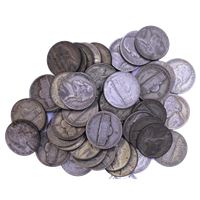35% Silver War Nickels
- Gold
- Silver
- Platinum
- Palladium
- 1 gram
- 2.5 gram
- 5 gram
- 10 gram
- 50 gram
- 100 gram
- 250 gram
- 1/20 oz
- 1/10 oz
- 1/5 oz
- 1/4 oz
- 1/2 oz
- 1 oz
- 2 oz
- 5 oz
- 10 oz
- 20 oz
- 50 oz
- 100 oz
- 1/2 kilo
- 1 kilo
- 5 kilo
- 10 kilo
35% Silver War Nickels
35% Silver War Nickels have gained in popularity among silver investors in recent years, given the low premium over their melt value at which they are usually offered. these coins are attractive to a much broader consumer base than merely coin collectors thanks to their pure silver content, an aberration in the long-standing jefferson nickel series (1938-present). in fact, war nickels mark the only time that a regular issue five-cent coin from the u.s. mint contained silver; all previous and subsequent issues have been made from 75% copper and 25% nickel.
At the same time, coin collectors also appreciate the War Nickel issues for their novel composition, making them perfect pieces in a Type set. This is a similar scenario to the “Steel Pennies” from the World War II years, which featured an uncommon composition for several years as coinage metals began to be diverted toward the manufacture of war materials. More commonly, however, war nickels are sold in large bags based on their total face value, the preferred way for precious metal investors to stack them up affordably for their 35% silver content.
Origin of the Silver “War Nickel”
During the Second World War, the United States removed the nickel content from the five-cent piece so the metal could instead be used for the war effort, where nickel proved indispensable for stainless steel production. Thus, 35% Silver War Nickels were manufactured from mid-1942 through the end of the war in 1945. The metal alloy used for these special “nickels” was 56% copper, 35% silver and 9% manganese. Figuring out the exact composition of a coin with no nickel that was the same size and weight as the original issue was important; otherwise, these war-era coins would not have worked in vending machines and other coin-operated machines. Each war nickel contains a total of 0.0563 troy ounce of fine silver content.
35% Silver War Nickels were to be removed from circulation after the war, though this task proved a bit too cumbersome in the end, and many were left in active circulation. To distinguish these coins from their non-silver counterparts, the Mint made a minor design alteration, placing a large mintmark above the dome of Monticello on the reverse rather than on the obverse of the coin. This is still the quickest way to tell if your Jefferson nickel contains silver or not; you can also check for the dates 1942, 1943, 1944, and 1945.

